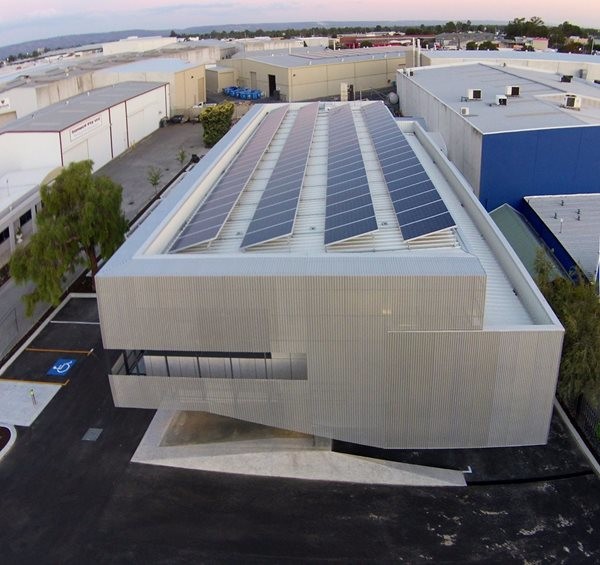The relatively new phenomenon of ‘hybrid solar’ generally comes about by combining a typical grid-connected photovoltaics (PV) system with batteries. The technology means residences and businesses can store excess power, to offset peak load, for night-time use or to possibly even take a household or business off the grid.
The systems generally use a smart inverter to channel power from the sun directly into a building, for use as required. Any excess electricity can be directed back into the grid (to benefit from feed-in tariffs), or to the system's batteries for evening and morning use.
Even without solar panels, the batteries can also draw power from the grid during 'off-peak' period and store it for use later when the grid has moved to peak.
This all sounded pretty great only last year when we first wrote about solar storage. At the time, it seemed to be only just peeking over the horizon. Energy companies were fighting fiercely to have both large and small scale Renewable Energy Targets either cut or abolished.
That trend is headed squarely in the other direction. Solar is unlikely to lose government support in the medium term. For instance, the Labor Party announced plans for a 50 per cent renewable energy target by 2030 if it wins government.
What’s more relevant is the rapid improvement in technology and its economic viability.
And the power companies have switched tacks and are looking for a slice of the action, launching their own solar battery offerings.
There’s no shortage of hyperbole. Analysts are likening the change the technology will bring to the energy industry to that which the mobile phone brought to telecommunications.
It’s "the biggest change in their industry in more than a century", according to Giles Parkinson from Renew Economy. A “complete game-changer" for Bloomberg energy finance analyst Kobad Bhavnagri.
The Clean Energy Council has concluded that ‘embedded generation’ like solar PV will soon become the primary source of power of power to household, with grid-supplied power becoming a “a safety net supplier of last resort”.
It’s payback time: all about the money

The key factor is that the price is coming down, faster than expected, and even quicker than PV has done in recent years.
Earlier this year, US billionaire Elon Musk launched a lithium-ion battery called the Tesla Powerwall (pictured above) which is expected to sell in Australia next year for about $5,500, potentially providing a payback period of six years, according to UBS Bank.
Musk’s brand Tesla tells a compelling story and it’s having an impact in Australia, which the company expects to become one of its biggest markets. Learn more on the Tesla Powerwall in the video at the bottom of the page.
 By numerous reports, battery storage prices are already falling in anticipation of the Tesla product release. The price of Legato storage system (left) being offered by AGL dropped by a third in the first six months of 2015, according to website RenewEconomy, which it put down to the impending arrival of the Powerwall.
By numerous reports, battery storage prices are already falling in anticipation of the Tesla product release. The price of Legato storage system (left) being offered by AGL dropped by a third in the first six months of 2015, according to website RenewEconomy, which it put down to the impending arrival of the Powerwall.
The payback period on solar and battery installation is currently estimated by investment bank Morgan Stanley to be about nine years in Queensland, 16 years in NSW, and up to 38 years in Victoria.
The disruption to pricing is possible, according to Tesla, because it spread its research and development costs over a much longer period than its competitors.
The ABC reported in July that the Powerwall battery could be delivered and installed at around $1,100 per kWh of capacity compared to the current price of around $2,500 per kWh for comparable capacity units.
It’s this massive price drop which is expected to drive rapid uptake.
Why we can expect solar panels on double the number of roofs soon

Sanwell Ofiice Building, WA by Braham Architects features 30kW of photovoltaic panels. Photography by Stephen Schneider.
AGL, the country's biggest emitter of greenhouse, now forecasts the household solar market could be worth $2 billion a year by 2030. Not surprising then when they became the first energy retailer to launch a battery storage device into the Australian market.
The 6 Kilowatt-hours (kWh) model, from Legato, released is suitable for mid-sized household solar units but they also plan to develop a suite of products to cater to a range of home and business sizes and types.
Meanwhile, the other two big energy providers are also expected to follow suit. Origin is trialling residential battery storage products. There’s been speculation that EnergyAustralia looking at a package in partnership with Tesla's Powerwall.
Contrary to what some now believe, AGL claims batter storage will remain an early adopter product for next couple of years, mainly because the payback time for investing in the technology.
Prior to the Powerwall announcement, investment bank Morgan Stanley surveyed household and concluded that around 2.4 million households would take up the solar storage if the price was right.
As of yet, it is still largely unknown what level the adoption of the technology for larger building applications like apartments and office buildings. Some contend there will be little interest from apartment dwellers with insufficient rooftop space. But then, there are also rapidly emerging development models which are looking to incorporate solar solutions and distribute the benefits to multi-tenanted buildings.
There is also speculation that other disrupters may join Tesla, with names like Google and Apple being mentioned. Things in this space will only get more interesting.

